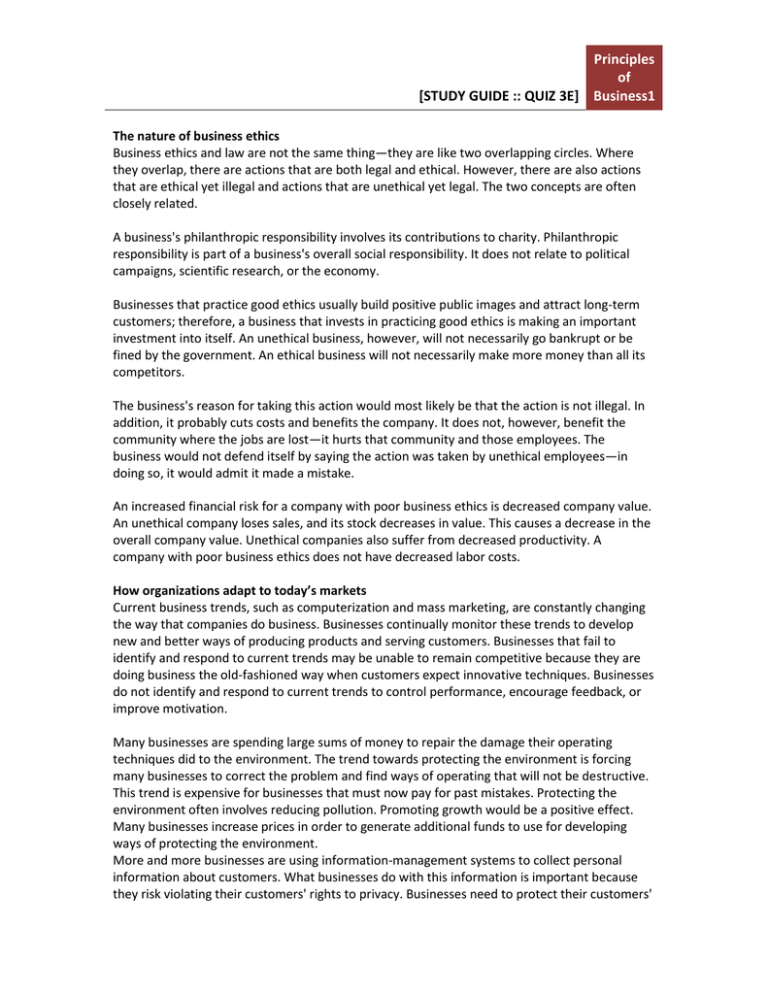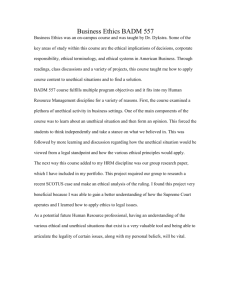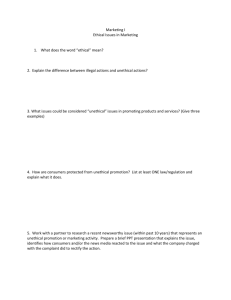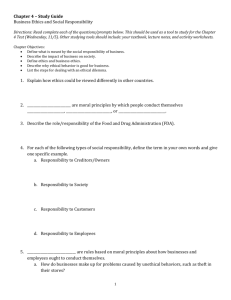Study Guide - Quiz 3E
advertisement

Principles of [STUDY GUIDE :: QUIZ 3E] Business1 The nature of business ethics Business ethics and law are not the same thing—they are like two overlapping circles. Where they overlap, there are actions that are both legal and ethical. However, there are also actions that are ethical yet illegal and actions that are unethical yet legal. The two concepts are often closely related. A business's philanthropic responsibility involves its contributions to charity. Philanthropic responsibility is part of a business's overall social responsibility. It does not relate to political campaigns, scientific research, or the economy. Businesses that practice good ethics usually build positive public images and attract long-term customers; therefore, a business that invests in practicing good ethics is making an important investment into itself. An unethical business, however, will not necessarily go bankrupt or be fined by the government. An ethical business will not necessarily make more money than all its competitors. The business's reason for taking this action would most likely be that the action is not illegal. In addition, it probably cuts costs and benefits the company. It does not, however, benefit the community where the jobs are lost—it hurts that community and those employees. The business would not defend itself by saying the action was taken by unethical employees—in doing so, it would admit it made a mistake. An increased financial risk for a company with poor business ethics is decreased company value. An unethical company loses sales, and its stock decreases in value. This causes a decrease in the overall company value. Unethical companies also suffer from decreased productivity. A company with poor business ethics does not have decreased labor costs. How organizations adapt to today’s markets Current business trends, such as computerization and mass marketing, are constantly changing the way that companies do business. Businesses continually monitor these trends to develop new and better ways of producing products and serving customers. Businesses that fail to identify and respond to current trends may be unable to remain competitive because they are doing business the old-fashioned way when customers expect innovative techniques. Businesses do not identify and respond to current trends to control performance, encourage feedback, or improve motivation. Many businesses are spending large sums of money to repair the damage their operating techniques did to the environment. The trend towards protecting the environment is forcing many businesses to correct the problem and find ways of operating that will not be destructive. This trend is expensive for businesses that must now pay for past mistakes. Protecting the environment often involves reducing pollution. Promoting growth would be a positive effect. Many businesses increase prices in order to generate additional funds to use for developing ways of protecting the environment. More and more businesses are using information-management systems to collect personal information about customers. What businesses do with this information is important because they risk violating their customers' rights to privacy. Businesses need to protect their customers' rights to privacy because customers who feel that businesses have misused their private information may stop buying from those businesses or go so far as to take legal action. Customers' access to credit, level of service, or need for information are not affected by a business's use of a marketing information system. Demographic trends refer to the physical and social characteristics of a population. Where people live and their ethnic backgrounds are demographic characteristics. For example, there is a growing trend towards urbanization, which means that more and more people are living in cities rather than in rural areas. Also, the population of many areas is becoming more multicultural, or made up of many different ethnic groups. Businesses consider demographic trends because they realize that changes in the population have an effect on how they market their goods and services to customers. Although where customers live may affect the environment, it's not an environmental trend. Likewise, where customers live can affect their access to technology; however, it is not a technical trend. Cultural trends would involve longterm changes to people's values and beliefs. They do not relate to the ages of people. E-commerce is a business trend that is expanding rapidly because of the Internet and the World Wide Web. E-commerce is changing the way companies do business because it allows them to be accessible to customers at all times. Customers who have access to a computer and the Internet can visit a business's web site and obtain information or shop online at any time of the day or night. As a result, more and more businesses are adding web sites to make their services and products available to customers at all times. The benefit to a business is often increased sales. The growth of e-commerce is increasing competition, which means that businesses often reduce prices and offer additional services to attract customers. Businesses do not use ecommerce to communicate with similar organizations.






